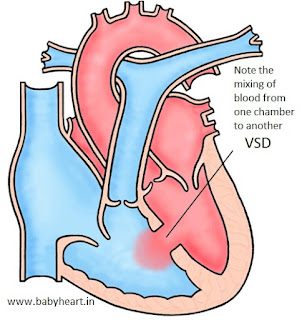We always talk about conditions affecting the heart later in life such as hypertension, coronary heart disease and heart failure. We don't talk much of any conditions of the heart which are present at birth, known as congenital heart disease or defects. Congenital heart disease, also abbreviated to CHD and not to be confused with coronary heart disease, is a type of defect or malformation in one or more structures of the heart or blood vessels that occurs before birth. These defects happen as the foetus is developing. CHD is more common than one thinks, occurring around 8 to 10 out of every 1,000 births. The cause is unknown in the majority of cases although certain conditions or factors can predispose a child to being born with CHD. They include genetic or chromosomal abnormalities in the child such as Down's Syndrome, viral infections in the mother during pregnancy such Rubella, and consumption of certain drugs or alcohol by the mother during pregnancy. There are many different types of CHD and they range from a mild form that can go undetected until much later in life to the very severe where the baby is cyanosed - bluish discolouration of the lips and face because of lack of oxygen in the blood - within days of being born. Let us just limit the discussion here to atrial and ventricular septal defects, known as ASD and VSD respectively. In layman's term, they are also known as hole-in-the-heart. You all knoe that the heart is divided into four chambers - two on the left where blood rich in oxygen from the lungs passes through to get to the body - and two on the right where blood lacking in oxygen returning from the body goes to before it gets back to the lungs. It is vital that the wall separating the two sides called the septum is intact. Any breach in the wall will mean that blood with different oxygen concentrations are mixed together. ASD is when the breach is in the septum between the two atria and likewise, VSD denotes a defect in the ventricular septum. This may not be a big problem in the beginning as the left chambers which have a higher pressure system than the right will direct blood to the right chambers via the hole or defect in the wall. However, as the pressure rises in the right chambers through the years because of constant flow of high pressure from the left, it can damage the lung causing pulmonary hypertension. When it comes to a point where both sides have the same blood pressure level, there is then a free mixing of high and low oxygenated blood on both sides resulting in body tissues being compromised of good oxygenation. The person will be cyanosed and breathless and may also have symptoms of heart failure. Of course, that is the extreme end of the spectrum. For most with ASD or VSD, they are fairly asymptomatic and the condition only gets discovered during a routine medical examination when a murmur - a characteristic sound heard by using a stethoscope placed on the chest over the heart - is detected. The definitive test is an echocardiogram which is an ultrasound scan test of the heart. When the septal defect is small the doctor will usually advise the person concerned to come back for a checkup every year or so. No regular medication is needed. He will be advised to take antibiotics as a preventative measure against bacterial infection affecting the heart (endocarditis) if he is going to have a dental procedure or any procedure that may cause bleeding. If the defect is big from the echocardiogram, then an interventional procedure or surgery to close the hole has to be considered. If you are a parent and you notice the following in your child - cyanosis of the skin, lips and fingernails, poor weight gain, fast breathing, recurrent lung infections and inability to exercise well, it is suggested that you bring your child to the attention of your doctor or paediatrician. There is a possibility that he or she has a congenital heart disease.
May 14, 2016
Subscribe to:
Post Comments (Atom)













0 comments:
Post a Comment